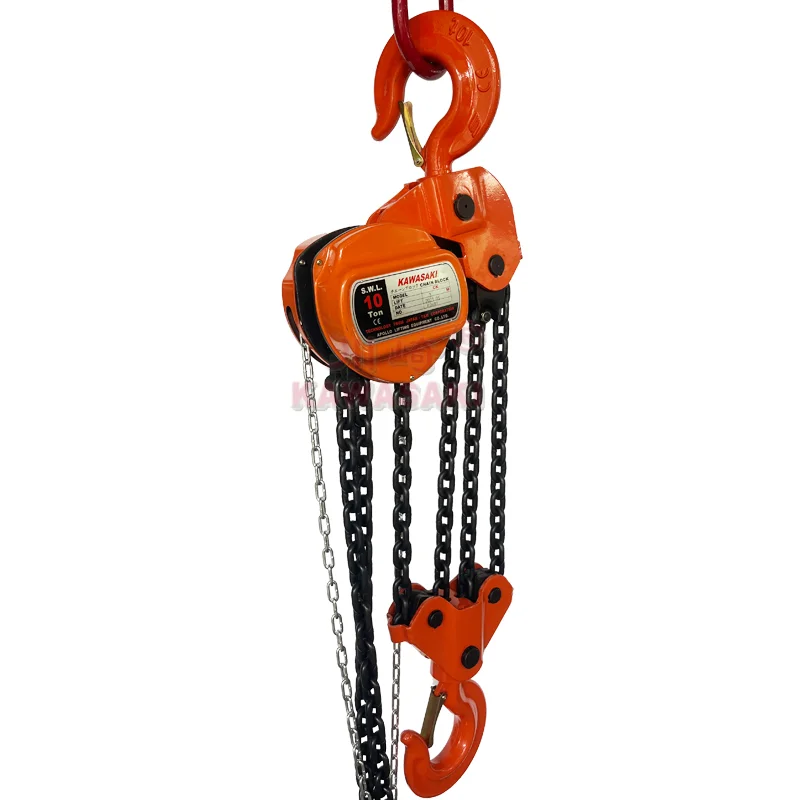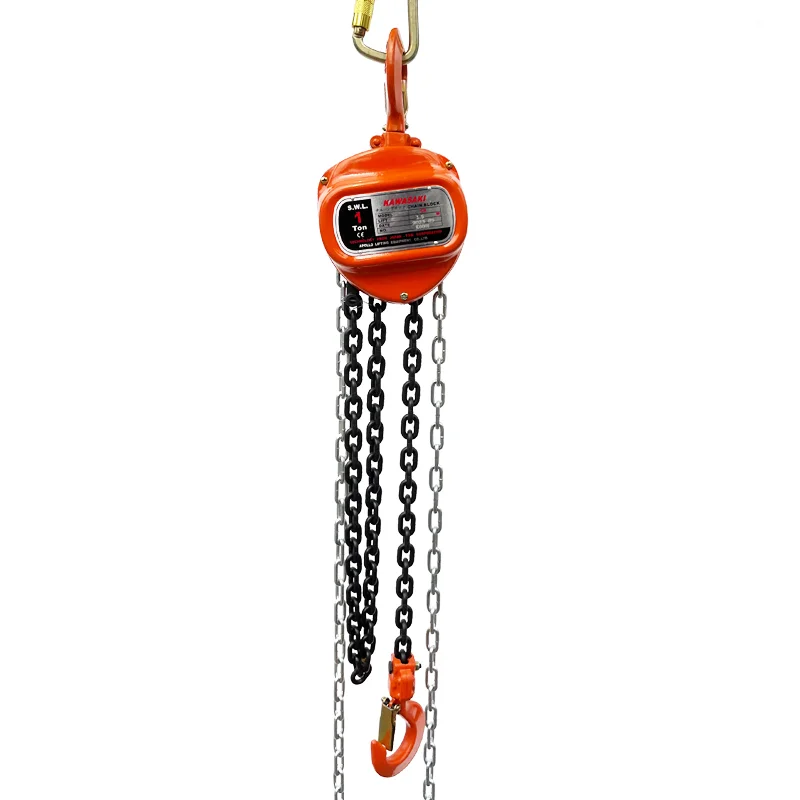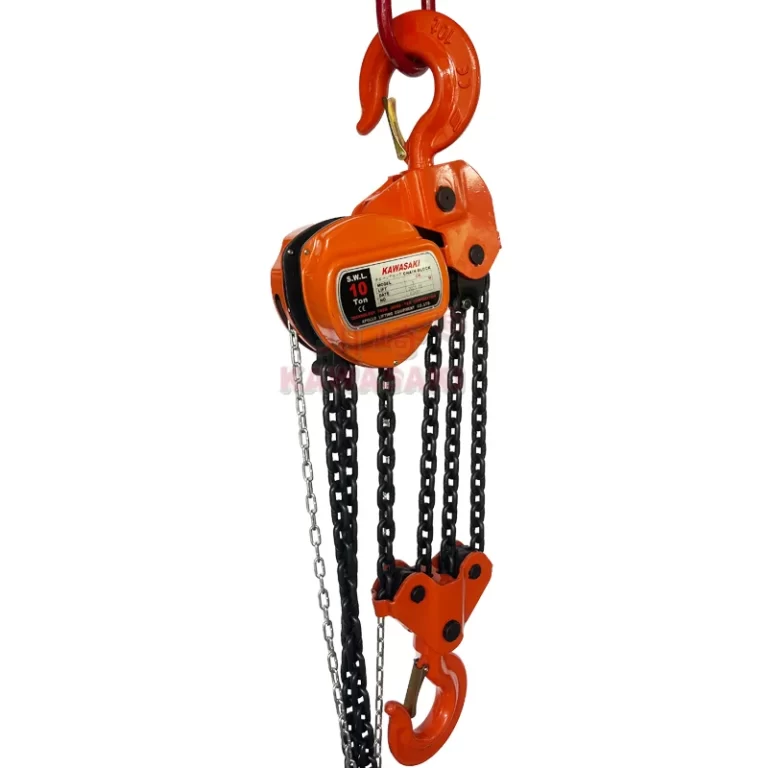How Manual Chain Hoists Work
Mechanical Principle
Manual chain hoists use a simple system with gears and pulleys. You pull a hand chain, and it makes the gears turn. This spins a sprocket that pulls up a load chain with the heavy stuff attached. It’s like magic—you don’t need tons of strength to lift really heavy things!
Key Components
- Hand Chain: You pull this to make the hoist work.
- Load Chain: This lifts and holds the heavy stuff. It’s usually made of strong T80or T100 alloy steel.
- Gears and Brake System: These control the lifting and keep it safe.
- Hooks: These hold the hoist up and grab the load.
Hand Chain Hoist vs. Lever Hoist
Both do similar lifting jobs, but they’re a bit different. Lever hoists are great for pulling things sideways or placing stuff exactly right. Manual chain hoists are best for lifting things straight up and down.
Key Advantages That Remain Relevant in 2025
No Power Source Required
Manual chain hoists don’t need electricity. That’s super awesome for places with no power, like shipyards, mines, or outdoor building sites. You can use them anywhere, anytime, without plugging anything in!
Cost-Effective and Low Maintenance
These hoists are way cheaper than electric ones. They don’t have motors or wires, so they don’t break as much. This means you spend less time and money fixing them. They’re perfect for saving cash!
Robust, Reliable, and Simple Design
Manual chain hoists are super tough because they have fewer parts. This means they don’t break down a lot. They’re great for rough places where you need something strong that keeps working.
High Precision and Control
When you pull the chain yourself, you can control exactly how fast or slow the load moves. This is awesome for delicate jobs, like fixing machines or setting up equipment just right.
Ideal Use Cases in Modern Industry
Remote and Off-Grid Worksites
In faraway places like oil fields, forests, or work camps, manual chain hoists are super handy. They don’t need power, so they work great where there’s no electricity.
High-Precision Maintenance Jobs
For jobs that need careful moves, like setting up delicate machines or lining up parts in a factory, manual chain hoists give you tons of control. They’re better than big automatic systems for these tasks.
Sectors with Strict Safety Compliance
Some places, like chemical plants or food factories, need tools that won’t make sparks. Manual chain hoists with special materials can be spark-proof. They’re safe without needing fancy electric safety gear.
Cost-Sensitive Applications
Small businesses or repair shops love manual chain hoists. They’re strong but don’t cost a lot, so you get great lifting without spending all your money.
Choosing the Right Manual Chain Hoist in 2025
Load Capacity and Lifting Height
You need to know how heavy your stuff is and how high you want to lift it. KAWASAKI’s CK series manual chain hoists can lift from 1 ton to 20 tons. You can also pick how high they lift to fit your job.
Certification and Safety Compliance
Make sure your hoist follows rules like CE, ISO9001, and GS. KAWASAKI hoists are tested a lot to make sure they’re safe and work great.
Suspension Type
You can choose a hook suspension, which is easy to move around, or a lug suspension, which stays in one place and is super steady. Pick what works best for your setup.
Customization Options
KAWASAKI lets you make your hoist just right. You can choose T80 or T100 load chains and coatings like nickel-plated, blackened, or Dacromet. They even let you pick colors, logos, or special boxes for shipping.
Maintenance and Safety Best Practices
Routine Inspections
Check the chains, hooks, and brakes often. Look for wear, bends, or rust. This keeps your manual chain hoist safe and ready to use.
Lubrication
Put oil on the chains and gears to keep them moving smoothly. This helps them last longer and work better.
Operator Training
Teach workers how to use the hoist safely. They need to know about load limits, how to position the hoist, and how to lift right. KAWASAKI gives videos and guides to help with training.
Lever Hoist vs. Hand Chain Hoist – A Quick Comparison
| Feature | Lever Hoist | Manual Chain Hoist |
| Best for | Pulling sideways, tensioning | Lifting straight up |
| Ease of Use | One-handed use | Two-handed use |
| Portability | Small and light | Heavier but super steady |
| Cost | A bit more expensive | Cheaper |
Real-World Use: A Snapshot
One of our Southeast Asian customers in the marine business uses KAWASAKI manual chain hoists to lift heavy gearboxes and generators on ships. With no need for electricity and rust-proof coatings, the 3-ton and 10-ton CK series hoists have worked great in salty, wet places for over five years!
Why It’s Still a Smart Choice in 2025
Even with fancy new lifting tools, manual chain hoists are still awesome because they:
- Stay tough in rough places
- Don’t need much fixing
- Lift things exactly right
- Don’t cost a lot to own
With brands like KAWASAKI making them even better, you get strong hoists that can be made just for you. They have cool features like 360° operation, load-limiting systems, and work with electronic scales. This makes them great for all kinds of lifting jobs.
Conclusion
Manual chain hoists are not old news. They’re better than ever with stronger materials, smarter designs, and cool safety features. Whether you’re in a faraway field, saving money, or need super exact lifting, KAWASAKI manual chain hoists made by APOLLO are a smart pick in 2025 and beyond. They’re tough, safe, and can be customized to fit your needs. With years of know-how, ISO9001 and CE/GS certifications, and great support, these hoists are a dependable choice for safe, fast, and long-lasting lifting.
FAQs
Q1: How do I choose the right capacity for a manual chain hoist?
A: Figure out the heaviest thing you’ll lift and add a 25% safety buffer. KAWASAKI has options from 1T to 20T with custom heights.
Q2: Can manual chain hoists be used for overhead lifting in commercial facilities?
A: Yup, as long as they’re set up safely and strong enough for the load. KAWASAKI hoists are certified for overhead lifting.
Q3: What kind of maintenance do KAWASAKI manual hoists require?
A: Oil the chains, check for wear, and inspect hooks and brakes. KAWASAKI gives videos and parts to make it easy.



